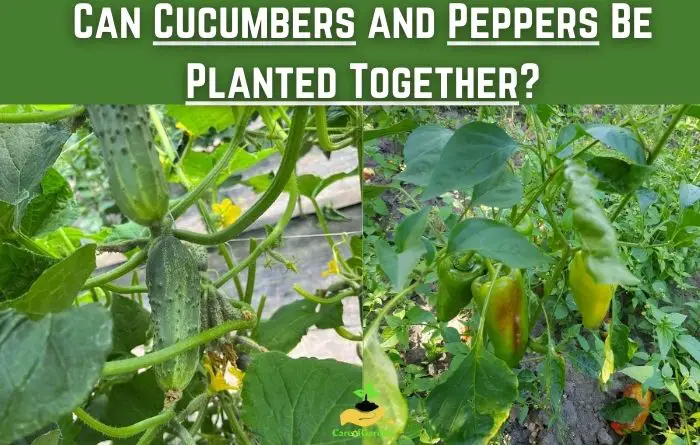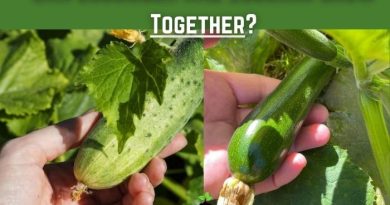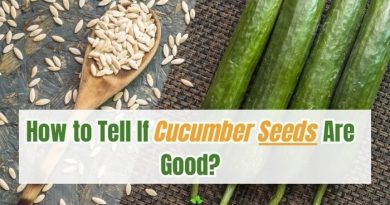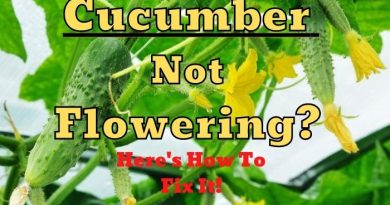Can Cucumbers and Peppers Be Planted Together? Answered!
Are you wondering if cucumbers and peppers can be planted together? In this blog post, I’ll explore the benefits of growing these two crops together, as well as provide tips on sunlight, soil, water, temperature, spacing, fertilization, and support requirements.
Can Cucumbers and Peppers Be Planted Together?
Yes, cucumbers and peppers can be planted together successfully with some careful consideration of their growing conditions. Both plants have similar sun, soil, and watering requirements, making it easier to provide optimal conditions for both crops.
Planting them together can also maximize yield, as the presence of cucumbers can provide some shading to the pepper plants, reducing heat stress and promoting healthy growth. Additionally, the strong scent of peppers can help deter common pests that may affect cucumbers, such as cucumber beetles.
However, it is important to ensure that the roots are not directly competing. This can be achieved by planting cucumbers in a separate area of the garden bed or by creating a triangular pattern of circular dips for the cucumber plants and planting the peppers around them.
Overall, cucumbers and peppers can be excellent companions in the garden due to their complementary growth habits and similar growing requirements.
What Growth Requirements Do Cucumbers and Peppers Have?
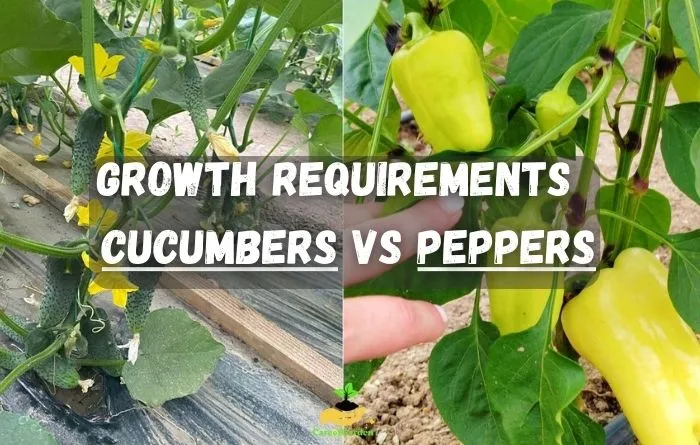
Let’s understand the individual needs of cucumbers and peppers before planting them together in the mixed culture. This way you can better assess whether it makes sense to plant cucumbers and peppers next to each other.
It is important to know the requirements in order to find a suitable compromise when choosing the location where you want to plant your cucumbers and peppers.
Here is a table outlining the compatibility of cucumbers and peppers:
| Growth Habit | Cucumbers | Peppers |
|---|---|---|
| Space Requirement | Cucumbers require ample space to spread and vine. | Peppers have a more compact growth habit. |
| Sunlight | Cucumbers prefer full sun exposure. | Peppers also need full sun for optimal growth. |
| Watering | Cucumbers require regular watering to keep the soil consistently moist. | Peppers prefer well-drained soil and should not be overwatered. |
| Pest and Disease Resistance | Cucumbers are susceptible to common cucumber pests like aphids and cucumber beetles. They are also prone to fungal diseases. | Peppers are generally less susceptible to pests and diseases compared to cucumbers. |
| Nutrient Requirements | Cucumbers benefit from rich soil and regular fertilization. | Peppers have lower nutrient requirements and can tolerate a wider range of soil conditions. |
https://extension.uga.edu/publications/detail.html?number=C1034
https://www.rhs.org.uk/vegetables/peppers/grow-your-own
1. Sunlight
Cucumbers and peppers have similar sunlight requirements and need at least 6-8 hours of direct sunlight daily to grow and produce fruit optimally.
It’s important to plant them in a location with full sun exposure and to avoid planting them in areas with shade or partial shade. When planting them together, it’s best to choose a location that receives full sun exposure throughout the day.
2. Soil
Both of these crops thrive in drained loamy soil that is packed with organic matter. Loamy soil consists of a mixture of sand, silt, and clay which provides optimal drainage and allows plant roots to breathe. Organic matter, such as compost or aged manure, helps improve soil fertility and structure.
It is recommended to plant cucumbers, like peppers, in soil that has already been fertilized since the fall. Fresh manure can cause excess green growth. Both cultures are fed with superphosphate, urea, potassium sulfate, humus, compost, and non-acidic peat.
However, it must be taken into account that for peppers the concentration of nitrogen and potassium fertilizers should be less.
It’s crucial to maintain the soil pH level within the range of 6.0 to 6.8 and a soil test can help determine if any amendments are needed. When planting these crops together it’s advisable to prepare the soil by incorporating matter while ensuring proper drainage.
3. Watering and humidity
Cucumbers and peppers have similar water needs and require consistent and regular watering, especially during periods of dryness. It is essential to maintain the soil moist without making it waterlogged as excessive watering can result in root rot and other problems.
From experience, I advise you to water once or twice a week depending on the weather conditions and moisture levels in the soil.
When planting them together it is advisable to ensure that the soil has drainage capabilities and that the plants are adequately spaced to prevent overcrowding. Additionally, it’s important to avoid overhead watering, as this can promote the spread of diseases.
But cucumbers and peppers have different preferences for air humidity. For cucumbers, it can reach 90%, and for peppers it should not exceed 70%. Cucumbers grow well in the microclimate of an unventilated greenhouse. Peppers, on the contrary, need air movement but do not tolerate drafts.
4. Temperature
Both cucumbers and peppers are heat-loving plants, and they thrive in warm temperatures. They thrive in warm climates and prefer temperatures, between 70°F to 85°F (21°C to 29°C) for optimal growth.
For cucumbers, fluctuations from 18-20°C (64.4 to 68 degrees Fahrenheit) are optimal, and for peppers – from 22-25°C (71.6 to 77 degrees Fahrenheit).
It’s crucial to plant them after the last frost date in your region as they are sensitive to temperatures and frost.
When planting them together I recommend you choose a spot that gets plenty of sunlight and is shielded from cold winds.
4. Spacing
Cucumbers and peppers have different spacing needs because of their growth habits however, I know they can still be planted together with the right amount of space.
Cucumbers require more space since they spread out and vine. Plant cucumbers, from 36 to 60 inches apart depending on the type, and peppers around 18 to 24 inches apart.
When planting them together, it’s best to plan the layout carefully and ensure that each plant has enough space to grow and produce fruit.
5. Fertilization
Both crops benefit from balanced fertilization which consists of equal amounts of nitrogen, phosphorus, and potassium along, with micronutrients.
It’s important to fertilize the plants when you initially plant them and then continue doing it every 3 to 4 weeks throughout the growing season. However, be cautious not to overdo it with the fertilizer as excessive foliage growth can hamper fruit production. Follow the recommended application rates carefully.
Generally speaking for every 100 feet of cucumber plants you should apply around 1-2 pounds of fertilizer. If you’re growing cucumbers in a container aim for 2-4 tablespoons of fertilizer per gallon of soil.
As for peppers they require nitrogen during their early growth stages but will benefit from increased phosphorus and potassium as the fruits start developing.
Two weeks after planting them add 45 percent of the nitrogen. Save the remaining 25 percent for the weeks when your pepper harvest is nearing completion.
5. Support
Cucumbers often require trellises or stakes for support as they vine and spread. Providing support keeps the fruit off the ground, reduces the risk of disease, and makes it easier to harvest.
Peppers, on the other hand, usually grow upright and may not need support, but it can help to keep the plants organized and prevent them from falling over in windy conditions.
6. Pest and Disease Control
Both cucumbers and peppers are vulnerable, to pests and diseases that often occur in gardens. Cucumber beetles, aphids, and spider mites are examples of pests that can harm cucumbers while pepper weevils, flea beetles, and aphids can pose a threat to peppers.
It’s crucial to check for signs of pest infestation and take measures to control them such as using insecticidal soap or neem oil. Additionally practicing crop rotation can be beneficial in reducing the risk of soil-borne diseases, like verticillium wilt or bacterial spot.
What varieties of peppers are compatible with cucumbers?
Some of the best pepper varieties to grow with cucumbers, I know, include:
- Sweet Bell Peppers: You can consider choosing bell peppers like California Wonder, King Arthur or Red Beauty for your cucumber garden. These varieties have a growth habit and won’t compete for space.
- Banana Peppers: If you’re looking for peppers that can coexist harmoniously with cucumbers, banana peppers are an option. Varieties such as Sweet Banana, Hungarian Wax, Anaheim, and Serrano are preferred.
- Jalapeño Peppers: Jalapeño peppers and other hot pepper varieties can also be planted alongside cucumbers without any issues. They have an upright growth pattern that makes them suitable companions.
- Mini Sweet Peppers: If you’re looking for pepper options that won’t take up too much space in your garden consider compact varieties, like Mini Belle or Baby Belle. They can be planted near cucumbers without any problems.
- Cubanelle Peppers: Another mild and sweet pepper variety to consider is Cubanelle peppers. They have a growth pattern similar to banana peppers and can be grown alongside cucumbers.
How far apart to plant cucumbers and peppers?
Cucumbers and peppers should be planted at different distances apart due to their growth habits. Cucumbers require more space as they spread and vine. Plant cucumbers 36 to 60 inches apart, depending on the variety, and peppers 18 to 24 inches apart.
Proper spacing helps to avoid overcrowding, promote good air circulation, and prevent shading. By meeting these spacing requirements, gardeners can help ensure healthy growth and fruit production for both crops.
Can Cucumbers and Peppers be Planted Together in Pots?
Yes, cucumbers and peppers can be planted together in pots, as long as they have enough space, sunlight, water, and nutrients. When planting them together in a container, it’s important to choose a pot that is large enough to accommodate both crops and has good drainage.
A 5-gallon pot is generally sufficient for one cucumber plant and one pepper plant. It’s also important to provide support for the cucumber vines, such as a trellis or stake system. When watering, it’s important to keep the soil evenly moist but not waterlogged and to avoid overhead watering, which can cause the appearance of diseases.
Can Cucumbers and Peppers be Planted Together in Raised Beds?
Raised beds provide ideal conditions for mixed cultivation of cucumbers and peppers because they provide good drainage and the ability to control soil. Here you should use a well-drained raised bed soil and add additional sand to the soil (in areas where the peppers are planted).
As mentioned above, peppers should be planted closer to the lighted wall than cucumbers so that they do not interfere with each other too much.
The distance between the bushes should be kept the same as with standard planting (for different varieties it can vary by one and a half to two times), but the distance between the beds should be maintained at least 90 cm.
This improves drainage, which is particularly beneficial for pepper plants. Since the soil dries out more quickly in raised beds, regular watering is particularly important.
By using drip irrigation, you can automate the water supply and ensure that both types of plants are optimally cared for. Don’t forget to add compost or well-rotted manure to the raised bed before planting and to give the cucumbers additional fertilizer during the growing phase.
Can cucumbers and peppers be grown together in the same greenhouse?
Yes, cucumbers and peppers can be grown together in a greenhouse. The controlled environment of a greenhouse offers some additional advantages, such as high humidity, which is beneficial for both plants.
To improve the soil, high-quality potting soil with added sand for improved drainage is recommended. Regular fertilization with organic fertilizer such as compost or well-rotted manure is also essential, with additional fertilizer given to cucumbers during the fruiting phase.
You also need to ensure that both crops receive enough sunlight, with peppers pinched at a height of 45-55 cm to encourage bushy growth and cucumbers pulled up using supports to reach a height of 150-180 cm.
Planting in a checkerboard pattern with a distance of 50 cm between adjacent plants is recommended, with legumes and vegetable crops like beans and peas planted along the perimeter of the cucumber beds.
Depending on available space, either option 1 (cucumbers in the northern bed, peppers on the southern side) or option 2 (cucumbers in the center, peppers in a side bed closer to the light) can be used.
Conclusion
So, to answer the question of whether peppers and cucumbers can be cultivated together, I can confidently answer yes. They are neutral in relation to each other, have similar technical conditions, and in practice often coexist perfectly in neighboring beds, both in the open air and in a greenhouse.
In fact, we personally have not planted cucumbers and peppers next to each other, except in separate containers. Of course, this doesn’t count as a mixed culture, but we have often planted cucumbers with what were supposed to be “bad neighbors”. Basically, you can plant a lot of crops together that don’t seem to have anything in common in terms of their requirements.
Often a compromise can be found that may not maximize the yield, but still brings a lot of fun and enjoyment. We often plant cucumbers and tomatoes together, which are also considered bad neighbors. However, with the right precautions and careful care, this mixed culture can also be a complete success.
Frequently Asked Questions
Yes, cucumbers and peppers can be planted together as companion plants in the same garden space.
Companion planting cucumbers and peppers provides several benefits such as pollinator attraction, pest and disease management, flavor enhancement, maximizing space and light, and weed suppression.
When cucumbers and peppers are planted together, the low-growth habit of cucumbers and the taller pepper plants can provide shade for the soil, preventing weed growth and soil drying, while also allowing for efficient use of garden space and light.
Yes, by incorporating companion plants like alliums, basil, cilantro, and hot cherry peppers, which attract beneficial insects and repel problem pests, the need for toxic pesticides can be reduced, promoting organic gardening and conscious living.
Cucumbers and peppers are warm-season crops that require ample sunlight. They should be planted in an area with full sun exposure. They also have similar requirements for soil and water conditions.

